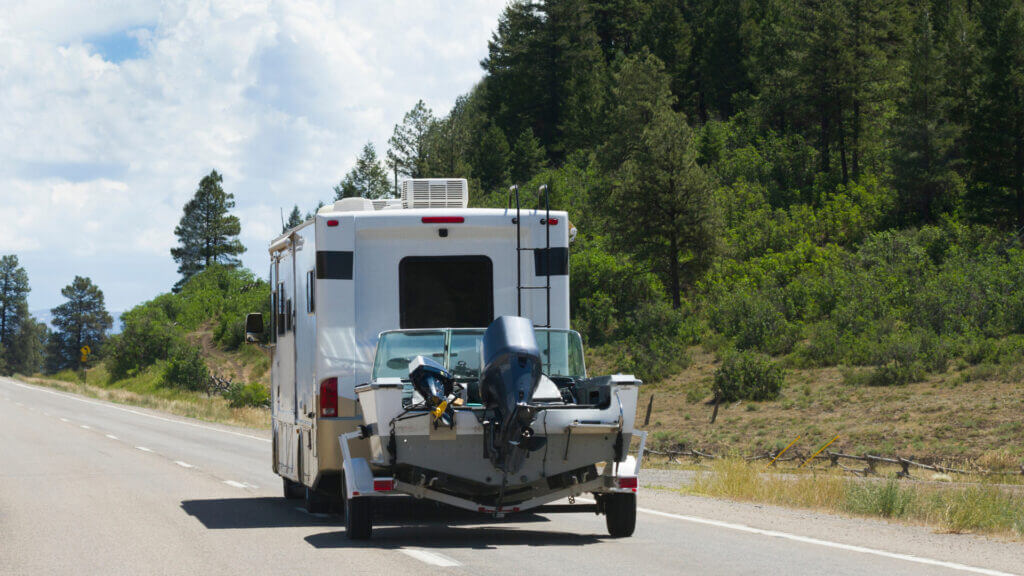Table of Contents Show
If you’ve thought about RVing, you’ve probably wondered, “How much is RV insurance?” An RV is typically much more expensive than a car. They’re also much larger and can cause more damage if there’s an accident. As a result, RV insurance can come with a hefty price tag. But many factors go into it, and you should understand them before you buy.
What Is RV Insurance?
RV insurance is like car insurance, but it covers your RV. Prices and regulations vary based on RV type, your state, and what you do with it.
For example, state laws require motorhomes to have insurance. After all, you’re driving the motorhome itself. If you have a travel trailer or fifth wheel, laws rarely require insurance. But that doesn’t mean you should go without it!
Even if it weren’t for state laws, we would still highly recommend you purchase RV insurance to protect your investment. How much RV insurance is will depend on the type of rig and the purpose. Weekend warriors and full-timers, for example, will experience vastly different costs.
What Is Full-Time RV Insurance?
Full-time RV insurance differs from car insurance. It’s also different from insurance needed for casual RV use. After all, when you’re a full-timer, your rig is not just a vehicle; it’s also your home. Full-time RV insurance provides additional coverage similar to homeowners insurance, but it’ll cost you.
Most insurance companies charge full-timer prices if you live in your RV for six months or more in a calendar year. Prices vary drastically for this type of insurance. We’ll cover costs for all types of RV insurance, so don’t stop reading now.
What Does RV Insurance Cover?
RV insurance coverage varies between recreational and full-time policies. But there are some things you can expect regardless of the policy type.
Collision insurance covers damage to property and people, including damage caused by someone else. You can also include comprehensive insurance that will cover damage not related to an accident. It includes things like trees falling or fires or protection if someone steals your RV.
Since RVs spend so much time outdoors (during travel and storage), comprehensive coverage is essential. After all, who knows when the RV park last trimmed their trees.
There are additional coverage options for full-timers. Full-time RV insurance can protect you if someone injures themselves while in your RV. It’s like homeowner’s insurance. For example, if a person falls down your steps and breaks their leg, insurance covers you if there’s a lawsuit.
Full-time RV insurance also lets you purchase additional coverage for your personal effects. If someone steals your possessions or an accident or fire destroys them, insurance will cover you. You can decide how much coverage you want for this area, and after meeting your deductible (if any), insurance will reimburse you for any loss and often go above and beyond that number.
How Much Is RV Insurance?
So, how much is RV insurance? Well, it depends. According to Progressive, you can get coverage for some RVs for as little as $125 a year. But if we’re being honest, getting insurance for that low of a rate is highly unlikely. Maybe you can get that price if your RV is ancient, you have a super high deductible, and it sits in storage all year.
Here are some yearly estimates for RV insurance. Remember, these rates will vary based on where you live as well.
Class A: If you have a class A RV and use it for less than half the year, you can expect to pay between $1,000-$1,500 per year. But if you’re a full-timer, you’ll probably spend much more. Full-time insurance in Michigan, for example, can cost over $3,000 per year. (One of the most expensive states for vehicle insurance).
Class B: Class B RVs are the smallest of the motorhome group. A traditional vehicle insurance policy can cover most class Bs. As such, insurance will probably cost a lot less. You can expect your costs to be similar to what you currently pay for your vehicle. Since these vary so much by state, it’s hard to make precise estimates. But you can probably expect to pay at least $500-$1,000 per year for a class B RV insurance policy.
Class C: Class C RVs are always right in the middle of the motorhome pack. They’re in the middle for size, gas mileage, and also insurance costs. Average rates for a class C are $800- $1,000 or more. If you’re a full-timer, expect to pay a higher rate on class Cs, just like a class A.
Travel Trailer/ Fifth Wheel: Since travel trailers and fifth wheels are towable rather than drivable, they’re less costly to insure. If you have an older model, you might get that low price of $125 per year if you use it sparingly. But for newer, more expensive towable RVs, you might pay over $1,000 per year.
If you are looking for a little more specific number to add to your budget check out Good Sam Insurance. You can get a quote after adding in a few details.

Factors That Affect RV Insurance Rates
As we mentioned above, these prices are just estimates. Many other factors affect the “how much is RV insurance” question. Here are some of the most common things that could change your RV insurance costs.
Class of RV
As we covered above, insurance cost differs based on RV class. Class A RVs are the largest and, therefore, most expensive to insure. Towable RVs are typically the least expensive.
Full-Time or Recreational Use
The more you use your RV, the more likely you are to get in an accident. So, if you’re a full-timer, you’ll pay more for insurance than a recreational user. Full-time insurance also often includes the additional coverages discussed early. This added coverage is another reason for higher premiums as a full-timer.
Driving, Accident, and Claim History
How much is RV insurance? It depends a lot on your driving! If you have a history of accidents, driving violations, DUIs, or claims, you’ll pay more. You’re riskier to the insurance company, so your rates will go up.
So, if you’re thinking about buying an RV, drive safely. You can sometimes decrease your premiums by taking a driving class as well.
Deductible Amounts
Your premiums will also vary depending on your deductible. A lower deductible means you’ll pay less out of pocket for the damage. But it also means you’ll have higher premiums. If you have a beefy emergency fund, you can lower your insurance costs by increasing your deductible. Then, you’ll only have the added expense if you get in an accident.
Any Preferred Additional Coverage
Additional coverage will also cost you more. Optional coverage may include personal effects, roadside assistance, emergency expense coverage, or windshield deductibles.
If you have a new RV, you can also opt for a total loss replacement. This means if insurance declares your RV a total loss, they will pay for a similar replacement. Since RVs depreciate rapidly, especially in the first few years, the extra cost might be worth it.







There is a lot more to be considered and the rates are all over the place.
I just purchased a 2014 Entegra Anthem (still at the dealership!!) and considered the Cornerstone.
Hartford is charging $1611/yr for insurance. For the Cornerstone (same year)it is $3154
To compare- Progressive quoted me $3675 for the Anthem and $5247 for the Cornerstone.
For transparency: All coverages were exactly the same with the exact same deductible. All I did was switch the vehicles. This is for part-time use with $300,000/$500,000 coverage